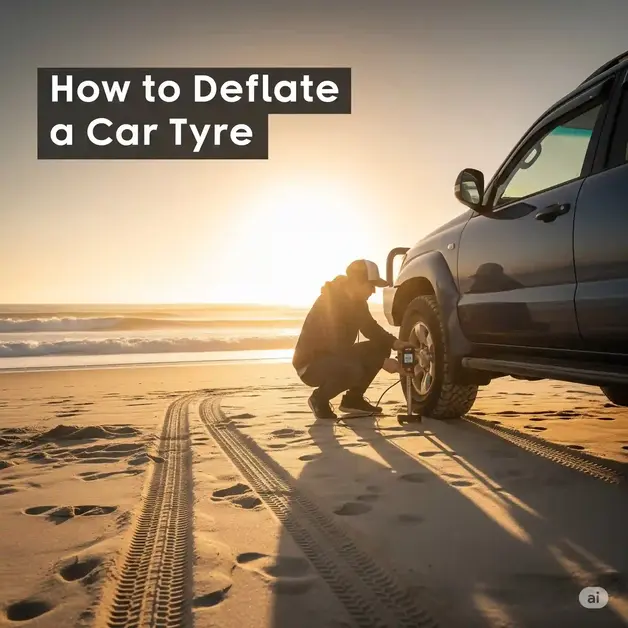It was a hot summer afternoon when I found myself stuck in soft beach sand, tyres spinning and going nowhere. I had no idea how to deflate a car tyre, and honestly, I didn’t even know why I needed to. That moment taught me a lesson I never forgot—sometimes, letting air out of your tyres can make all the difference in getting out safely and keeping control.
Knowing how to let air out of a car tire isn’t just for off-roaders or car nerds. It’s something every driver should know, especially if you’re ever driving on sand, gravel, or snowy roads. Over the years, I’ve learned the safest and quickest ways to do it—how to deflate a tire, how long it really takes, and even what not to do. In this guide, I’ll walk you through everything from personal mishaps to pro-level tricks so you don’t have to learn the hard way like I did.
Let’s dive in—and by the end, you’ll feel confident handling your tyre pressure no matter where you drive.
When and Why You Might Need to Deflate Your Tyres
Sometimes, letting a little air out of your tyres can feel like magic. I learned this the hard way—on a sandy beach, stuck with spinning tyres and a crowd of beachgoers watching. I thought more air meant more power. Turns out, the opposite was true. Less air gave me the grip I needed to drive out safely. That moment changed how I saw tyre pressure.
You might need to deflate your tyres for better traction. Whether you’re driving through soft sand, rocky trails, or snow-covered roads, reducing tyre pressure helps the rubber spread out and grip better. It’s like giving your tyres extra surface area to hold onto whatever you’re driving over.
On rainy days, slightly lower pressure can help your tyres stick to the road. Over-inflated tyres tend to skate on water or loose surfaces. A small pressure drop—just 2–3 PSI—can make your ride feel more stable and less bumpy.
Off-roading is a big reason drivers deflate. If you’ve ever been on a dirt trail or gravel path, you know how rough it gets. Letting air out softens the ride and reduces the chances of tyre damage. I remember bouncing all over a rocky hill until I let some air out—after that, the car felt like it floated over the bumps instead of fighting them.
Sometimes you might even need to let air out after accidentally over-inflating your tyres at a gas station. It’s easier than most people think, and knowing how to do it safely gives you full control over your tyre health.
Driving long distances with a heavy load? Lowering tyre pressure just a little can help balance out the weight. It keeps your tyres from wearing unevenly and gives you better grip, especially if you’re towing a trailer or carrying lots of luggage.
Here’s a quick guide:
- Sand – Let air down to 15–18 PSI for more grip.
- Gravel or dirt – Around 26–32 PSI smooths the ride.
- Heavy loads – Check your manual, but a slight drop can help comfort and control.
In short, deflating tyres isn’t just for adventure seekers—it’s for anyone who wants to drive smarter and safer. Once you know when and why to do it, it becomes second nature. I used to panic when I saw soft sand or muddy tracks. Now, I smile, hop out, drop the pressure, and go. It’s one of those small skills that makes a big difference.
Tools You’ll Need to Deflate a Car Tyre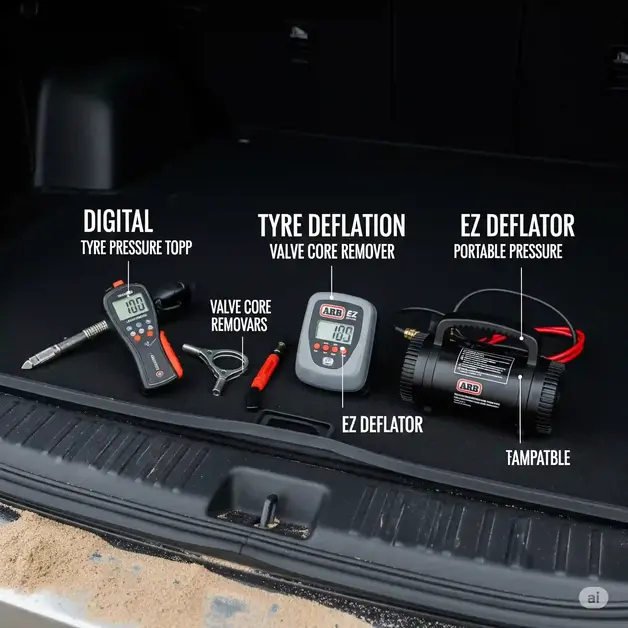
You don’t need a whole toolbox to let air out of a tyre—but having the right tools can make things quicker, easier, and a lot safer. When I first tried to deflate a tyre on the beach, I used a stick I found near the dunes. Seriously. It kind of worked, but I wouldn’t recommend it. Since then, I’ve learned there are better ways.
Short answer: To deflate a car tyre safely, all you really need is a valve tool or even a pressure gauge—but a proper tyre deflator makes it way easier and more accurate.
Tyre Pressure Gauge
A tyre pressure gauge is a must-have tool. Whether you’re letting air out for sand driving or correcting over-inflation, it tells you exactly where your PSI stands.
. A basic analogue pressure gauge does the job, but I prefer a digital one—it’s faster, easier to read, and less fussy when your hands are sandy or cold.
Answer-first insight: A tyre pressure gauge helps you check PSI so you don’t over-deflate and risk a flat.
When I upgraded to a digital gauge, it changed the game for me. It showed me just how far off my guesswork had been. Don’t trust your gut—trust the numbers.
Valve Core Removal Tool
If you need to deflate a tyre quickly—like in an off-road emergency—this tiny tool can help a lot. It unscrews the valve core from inside the valve stem, which lets air rush out fast. But here’s the catch: if you’re not careful, you can lose the core or let out too much air. For quick deflation in off-road emergencies, a valve core removal tool works fast—but be careful not to overdo it.
Quick fact: A valve core removal tool can deflate a tyre in seconds, but it’s not ideal for precise control.
I only use this when I’m in a real rush or when I want to do a full deflate before swapping a tyre. Just make sure you know how to screw the core back in tight—it’s a small part, but it does a big job.
Emergency Tyre Kit (Smart Addition)
For peace of mind, I carry a full tyre deflation and reinflation kit in my trunk. It’s saved me more than once when conditions changed suddenly.
Tyre Deflator Tools (Digital or Manual)
My go-to is the ARB EZ Deflator. It’s fast, accurate, and gives me total control. Perfect for dropping from 36 to 16 PSI before hitting sand.
I personally use the ARB EZ Deflator now—and I love it. It gives me total control without the guesswork.
Straight answer: A quality tyre deflator tool gives you both speed and accuracy when lowering pressure.
When you’re off-roading and need to drop from 35 PSI to 18 PSI, this tool saves time and keeps you safe. It’s especially helpful when you’re doing all four tyres and don’t want to kneel down forever.
Can You Deflate a Tyre Without Any Tools?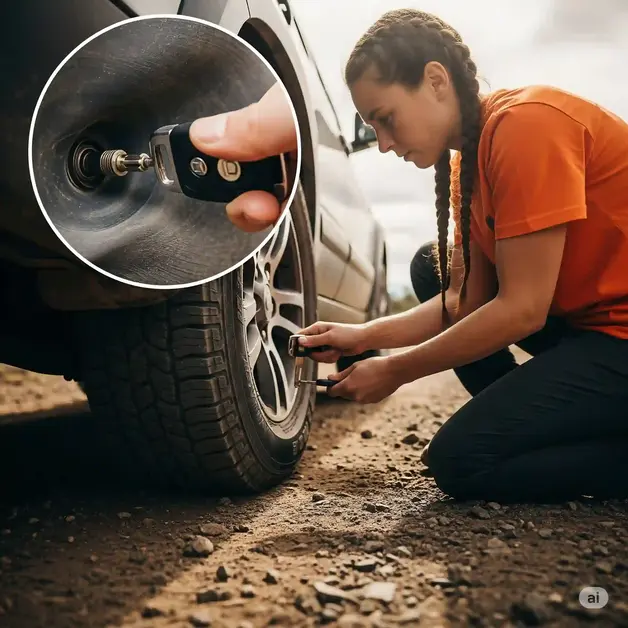
Yes—you can do it with just your fingers or a car key, but it’s not ideal. You press the metal pin inside the valve stem and let air escape, slowly. But it’s hard to control, and you might release too much without realizing it.
Real answer: You can deflate a tyre without tools, but it’s slow, messy, and easy to overdo.
I’ve done this in a pinch—like when I overinflated at a gas station—but honestly, I always carry a gauge and a deflator now. Once you’ve got the proper tools, it just feels smoother and more professional.
No matter where you’re driving—sand, snow, or just the city—it’s worth keeping at least a pressure gauge and a compact deflator in your glove box or tool bag. These tools aren’t expensive, and they give you the confidence to adjust your tyre pressure anytime, anywhere. For me, they’ve turned unexpected road problems into quick fixes.
Recommended Tools for Tyre Deflation & Inflation
Make your tyre pressure adjustments fast, safe, and accurate with these top-rated Amazon tools I personally use and recommend:
- Digital Tyre Pressure Gauge – Easy-to-read, accurate readings every time
Check it out on Amazon - Valve Core Removal Tool – Great for fast deflation in a pinch
🔗 Grab one here - ARB EZ Deflator – My go-to for controlled, fast tyre deflation
🔗 Get it here - VIAIR 85P Portable Air Compressor – Inflate back to road pressure easily
🔗 See it on Amazon - Off-Road Tyre Deflator Kit (Boulder Tools) – All-in-one deflation kit in a compact case
🔗 Explore it here
Keep these in your glovebox or boot—you’ll thank yourself later.
Step-by-Step: How to Deflate a Car Tyre Safely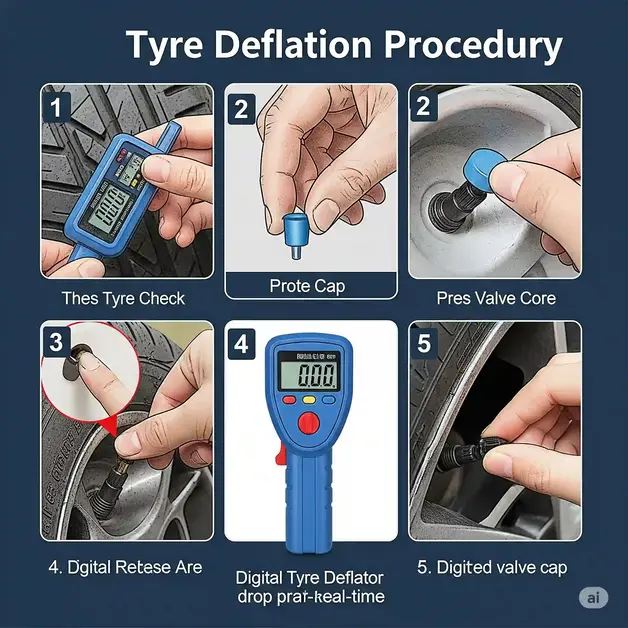
Deflating a tyre might sound like something only off-roaders or mechanics would care about, but trust me—it’s a skill every driver should know. The first time I had to do it, I was sweating bullets (and not just from the heat). I had no clue what I was doing. But once you understand the steps, it’s honestly easy—and kind of satisfying.
Short answer: To safely deflate a car tyre, check your current pressure, remove the cap, press the valve core to release air, monitor the PSI, then reseal the cap.
Let me walk you through it the way I wish someone had done for me.
Step 1 – Check Current Tyre Pressure
Before you touch the valve, you need to know where your tyre pressure stands. Use a tyre pressure gauge—digital or analogue. Just press it against the valve stem and note the PSI reading.
Quick tip: Most tyres sit between 32–35 PSI for normal driving. But that number drops if you’re driving on sand, snow, or rocky terrain.
The first time I checked mine before deflating for sand, it was 36 PSI. I knew I needed to drop that to about 16 PSI for better grip. That little number told me everything.
Step 2 – Unscrew the Valve Cap
You’ll find a small black or silver cap on the valve stem (that tiny tube sticking out of your wheel). Just twist it counterclockwise to remove it.
Real-world tip: Don’t lose the cap! Keep it in your pocket or cupholder while you work.
It sounds simple, but I’ve dropped more valve caps into mud and sand than I can count. Now I always carry a few extras—lessons learned.
Step 3 – Press the Valve Core to Let Air Out
Now comes the fun part—letting the air escape. You can press the small metal pin inside the valve using a key, coin, or even your fingernail. If you have a tyre deflator tool, attach it instead—it gives you better control.
Answer-first insight: Pressing the valve core lets air escape, but using a proper tool prevents over-deflation and makes the job easier.
When I did this by hand the first time, I kept stopping to check the pressure every few seconds. It worked, but it took forever. A proper deflator changed that. I just set the target PSI and watched it drop smoothly.
Step 4 – Monitor PSI Closely
As the air flows out, keep checking the pressure every few seconds. This is where a digital pressure gauge really helps. You don’t want to guess and go too low—especially if you’re just trying to fix an over-inflated tyre.
Safe range:
- Sand: 15–18 PSI
- Gravel/dirt: 26–32 PSI
- Rocks: 22–28 PSI
I’ve made the mistake of airing down too far once—went from 35 to 10 PSI thinking “the lower, the better.” Spoiler: it’s not. My tyres squished too much, and I almost popped a bead. Always check.
Step 5 – Replace the Valve Cap Securely
Once you’ve hit your target pressure, screw the valve cap back on snugly. This tiny step keeps dirt and water out of your valve and helps prevent slow leaks.
Final tip: Don’t skip the cap. It protects your valve from corrosion and air loss over time.
I used to think the cap was just cosmetic—until I had to replace a rusty valve that got jammed with sand. Now I treat that cap like gold.
Gear I Use to Deflate & Reinflate Tyres Safely:
(These are Amazon affiliate links. I earn a small commission if you buy through them—at no extra cost to you.)
🟢 Digital Tyre Pressure Gauge
🟢 Valve Core Remover Tool
🟢 ARB EZ Tyre Deflator (My Favorite)
🟢 VIAIR 85P Portable Air Compressor
🟢 Boulder Tools Tyre Deflator Kit
Let me know in the comments what PSI works best for you on sand, gravel, or off-road trails!
Final Thought Of How to Deflate a Car Tyre Safely
Deflating a tyre isn’t hard—but doing it right makes all the difference. Whether you’re prepping for a trail or just correcting an overfill from the gas station, this step-by-step process keeps you safe, in control, and confident.
Once you’ve done it a few times, you’ll wonder why you ever worried about it.
How Long Does It Take to Deflate a Car Tyre?
The short answer? It depends—but usually anywhere from 20 seconds to 3 minutes per tyre. The exact time comes down to how much air you’re letting out and what tool you’re using. I’ve timed this myself in different situations, and the range is wider than you’d think.
One time, on a solo beach drive, I used a basic key to deflate all four tyres. Let’s just say… my sunscreen wore off before I finished. It took almost 10 minutes total—and I still wasn’t sure if I hit the right PSI.
Average Deflation Time Based on PSI and Tools Used
If you’re just letting out a bit of air (say 2–3 PSI), you can be done in under 30 seconds per tyre, even using a car key. But if you’re dropping from 36 PSI down to 16 PSI for sand driving, expect at least 1–2 minutes per tyre with a manual tool—and less than 1 minute if you’re using a proper tyre deflator.
Quick fact: Using a tyre deflator tool cuts deflation time by nearly half and gives more accuracy.
When I switched to using the ARB EZ Deflator, it cut my total deflation time down to under 4 minutes for all tyres. That alone was worth the investment. Plus, it felt good knowing I wasn’t winging it.
Manual vs Tyre Deflator Tool Comparison
Let me break it down in real-world terms.
- Using your fingers, keys, or a pen tip:
- Slow and inconsistent
- Around 2–3 minutes per tyre for large PSI drops
- Risk of letting out too much air
- Slow and inconsistent
- Using a valve core removal tool:
- Super quick—20–30 seconds per tyre
- But risky if you’re not careful (you can lose the core or go too low)
- Super quick—20–30 seconds per tyre
- Using a tyre deflator (manual or digital):
- Fast and controlled
- Around 45–60 seconds per tyre for a 15–20 PSI drop
- Best balance of safety, speed, and precision
- Fast and controlled
I’ve tried them all. Deflating by hand works in an emergency, but once you go with a proper tool, there’s no going back.
My Own Timing Test Results (Real-World Anecdote)
Just last month, I did a little test in my driveway—because yes, I nerd out about this stuff. I timed how long it took me to air down from 36 PSI to 18 PSI using three different methods:
- With a key: Took me about 2 minutes and 20 seconds per tyre, and I had to stop often to check PSI.
- With a valve core remover: Done in 20 seconds, but I overshot once and had to re-inflate.
- With my ARB EZ Deflator: About 50 seconds per tyre, all four consistent, no stress.
Real answer: If you’re going for speed and safety, a tyre deflator tool hits the sweet spot.
So if you’re ever stuck between tools, think about how much time and confidence you want while crouched next to your car in sand, dirt, or snow.
When it comes down to it, deflating your tyres doesn’t take long—but doing it right? That’s what saves you from headaches later. Whether you’re adjusting a couple PSI or dropping for off-road grip, having the right gear and knowing your pace makes all the difference.
How to Quickly Deflate a Car Tyre (My Pro Tip)
If you ever find yourself stuck in sand or gearing up for some off-road fun, speed matters. You don’t want to waste 10 minutes crouching by each tyre. So here’s the fastest way I’ve learned to deflate car tyres safely—and it comes straight from real off-roading trips where every second counted.
Short answer: The fastest and safest way to deflate a tyre is to use a quality tyre deflator tool like the ARB EZ Deflator. It gives you quick, accurate pressure control without damaging the valve.
Let me explain why that matters.
I used to deflate tyres the slow, annoying way—pressing the little pin inside the valve stem with a key or screwdriver. It works, but it’s a pain. You’re stuck hunched down, guessing the pressure, and hoping you don’t go too low. I’ve even over-deflated by accident and had to reinflate in the middle of a sand trail. Not fun.
Then I found the ARB EZ Deflator. Total game changer. It connects to the valve stem, removes the valve core (but holds it safely), and lets the air out fast. You can literally watch the pressure drop on the built-in gauge in real-time. I can drop 10–15 PSI in less than a minute per tyre—and do it precisely.
Short answer: A deflator tool saves time, reduces guesswork, and prevents over-deflation.
What I love most is the control. It’s not just about speed—it’s about knowing exactly when to stop. When I’m on soft beach sand, I drop to around 16 PSI. For rocky trails, I stay closer to 25. The deflator tool helps me hit that target on the dot, every time.
There’s also less risk of damaging the valve or letting dirt in. That might sound small, but I’ve seen people ruin a tyre valve just from jabbing it with a stick or pen. Not worth it.
Short answer: Using a tyre deflator protects your valve stem and keeps dirt out while you deflate fast.
If you don’t have a deflator tool yet, I recommend getting one before your next trip—or even if you’re just prepping for wet roads or heavy loads. It’s a small investment that saves time, avoids frustration, and gives you confidence when you’re adjusting PSI under pressure (literally!).
I’ve kept mine in my glovebox for the past three years, and it’s never let me down.
Short answer: Keep a deflator tool in your car—it makes pressure adjustments quicker and safer in any situation.
Want to do it without a tool? Sure, you can, but it’s like cutting vegetables with a spoon. It gets the job done, just not well.
Once you try a proper deflator, you won’t go back.
How Much Air Should You Let Out for Different Situations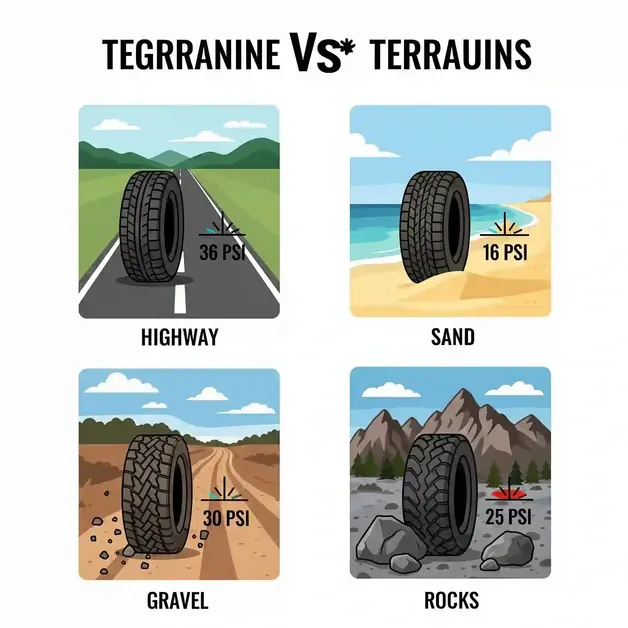
So, how much air should you actually let out of your tyres? The short answer: it depends on where you’re driving and what your car is carrying. There’s no one-size-fits-all PSI. It’s more like tuning your tyres for the terrain—like choosing the right shoes for the right activity.
I’ve learned this the hard way, especially on soft beach sand. The first time I aired down, I only dropped to about 25 PSI. The tyres still sank and spun, and I almost got stuck. A local guy came over, smiled, and said, “Mate, you’re still too hard. Go down to 16.” I did—and suddenly, it was like the car floated over the sand.
General PSI Guide (By Terrain)
Here’s a basic pressure guide I now follow, based on real-world driving and what’s worked best for me:
- Highway driving: 32–38 PSI
You want your tyres at full spec here. It’s all about fuel economy, tread life, and safety at high speeds. Check your car’s placard (usually on the door frame)—that’s your ideal PSI.
- Beach or soft sand: 15–18 PSI
Going this low gives your tyres a bigger footprint, so they “float” over sand instead of digging in. But don’t stay here on hard roads—you’ll damage your tyres or rims.
- Rocks and technical off-roading: 22–28 PSI
This softens the ride, lets your tyres wrap around rocks for grip, and helps avoid punctures. I’ve used 25 PSI on rocky trails and felt way more stable and planted.
- Gravel or washboard roads: 26–32 PSI
Slightly lower pressure takes the sting out of rough gravel. It smooths the ride and reduces the bounce you get on corrugated tracks. I use around 30 PSI for comfort without sacrificing control.
Short answer: Use higher PSI for smooth roads and lower PSI for traction on tricky surfaces like sand or rocks. Adjust based on where you are and how your tyres feel.
Things to Consider
Now, tyre pressure isn’t just about the terrain. Other things matter too.
- Vehicle load:
If you’re carrying a full family, camping gear, or towing something, keep your PSI on the higher end—even off-road. You don’t want the tyres too soft under a heavy load. I’ve noticed when fully packed for a trip, 18 PSI felt too low on sand. Bumping it to 20 made a difference.
- Tyre type and size:
All-terrain tyres behave differently than highway tyres. Larger tyres can handle lower pressures better without squishing too much. For example, my 33-inch A/T tyres handled 16 PSI fine on the beach, but I wouldn’t try that with basic passenger tyres.
- Your driving style:
Going slow and steady off-road means you can run lower PSI safely. But if you’re driving fast on gravel or mixed terrain, it’s smarter to stay on the higher end. Speed and soft tyres don’t mix well—you risk losing control.
Short answer: Adjust PSI based on your load, tyre type, and how aggressively you drive. Lower isn’t always better—it has to fit the situation.
To wrap it up, getting your tyre pressure right isn’t rocket science—but it does take a bit of feel and experience. I’d say start with the guidelines, but don’t be afraid to adjust based on how your car behaves. If it feels rough or unstable, pull over and tweak it. I’ve done this plenty of times—sometimes dropping just 2 PSI makes a huge difference.
Think of your tyres like your feet on a long hike. Too much pressure? You slip and slide. Too little? You tire out and hurt yourself. But get it just right—and you’ll feel like you can drive anywhere.
My Experience: What I Learned Off-Roading with Low PSI
The first time I aired down my tyres, I was nervous. I was parked at the edge of a beach trail, engine idling, with soft sand stretching ahead like a giant sandbox waiting to swallow my car. Everyone online said to drop the pressure, so I did. From 35 PSI, I let it down to about 16. And just like that, the whole car felt different.
Letting air out gives your tyres more grip by making the surface wider. That’s something I had read before, but you don’t really understand it until you feel it.
As I started driving through the sand, the ride felt smoother, almost like floating. The tyres stopped digging in and started gliding over the top. It was like going from flip-flops to snowshoes. Less air made the tyres “float” over the sand instead of sinking.
Lowering tyre pressure helps your car stay on top of soft ground. That’s a game-changer when you’re off-road.
But I’ll be honest—I made a rookie mistake. I got carried away and dropped one tyre below 12 PSI. That might sound fine, but it made the steering feel mushy. On turns, the tyre nearly rolled off the rim. That scared me more than the sand ever did.
Going too low can make your tyres unstable, especially on corners. Balance is key. You want enough flex for traction but not so much that you lose control.
After that trip, I started carrying a proper tyre deflator. It helped me get to the right PSI faster without guessing. I also marked down what pressure worked best on different terrains. For sand, I settled around 16–18 PSI. For rocky trails, I stick closer to 24–28 PSI. Each surface needs its own sweet spot.
Finding your ideal PSI is about trial and error—it’s not one-size-fits-all.
One more thing I learned: Always recheck pressure before heading back to pavement. I once forgot and drove several kilometers at low PSI. The tyres got hot, and the handling was awful. Luckily, I had a portable compressor in the boot, but I could’ve avoided the panic if I had double-checked before leaving the trail.
That whole experience taught me that tyre pressure isn’t just a number—it’s a tool. Learning how to use it gave me more control, more confidence, and way fewer “stuck in the sand” moments.
Managing your PSI properly turns you from a passenger into a driver with real control—especially off the beaten path.
Common Mistakes to Avoid When Letting Air Out
Letting air out of your tyres might seem easy—and it is. But it’s also surprisingly easy to mess up if you’re not paying attention. I’ve learned this the hard way, standing in the middle of a sandy trail with one tyre looking flatter than a pancake. If you’re new to deflating your tyres, here are a few mistakes I’ve made—or nearly made—that you can skip.
Letting out too much air too fast can cause problems.
I once got a bit too confident and dropped all four tyres to 10 PSI before a beach run. Big mistake. While the car floated beautifully on the sand, the sidewalls flexed too much on turns. I nearly lost control on a slight curve. That’s when I realized: every vehicle has a “sweet spot,” and going too low isn’t always better. A good range for sand is 15–18 PSI. For rocks, stick to 22–28 PSI. Don’t guess—know your limits.
Driving too fast with low tyre pressure is risky.
When your tyres are aired down, they lose stiffness and respond differently. I once took a gravel road a bit too quickly after dropping to 20 PSI. The handling was sloppy, and I could feel the tyres wobbling on corners. That was a wake-up call. Lower pressure helps with traction, but it also means slower, more controlled driving. It’s not just about deflating—it’s about adjusting how you drive too.
Forgetting to recheck tyre pressure can leave you stranded.
Sounds simple, right? But it’s easy to forget. I’ve had moments where I thought I let out just a few PSI, but the gauge said otherwise. One tyre dropped far lower than the rest, which threw off the handling. Always double-check your tyre pressure after airing down. Even a $10 pressure gauge can save you a lot of stress.
Not reinflating before hitting the pavement can damage your tyres.
After a fun trail run, it’s tempting to jump right back on the highway and head home. But if you’re still riding on low PSI, you’re playing with fire. I’ve made this mistake once, and it nearly cost me a tyre. The sidewalls overheated, and the steering felt like mush. Low-pressure tyres heat up fast on pavement. Always reinflate to your vehicle’s recommended PSI (check the placard on your door or glovebox) before you get back on the road.
Ignoring the valve cap is a small mistake that can cause big headaches.
Sounds silly, but I’ve dropped valve caps in the dirt more times than I can count. One time, I didn’t screw one back on properly, and dust got into the valve stem. Next morning? A slow leak and a flat. Always put the cap somewhere safe (like your pocket or dashboard), and make sure it’s back on snug before you drive off.
Letting air out of your tyres is a smart move in the right situations—but only if you do it right. Treat it like a tool, not a trick. Take a moment to be precise. Trust me, your tyres—and your ride—will thank you.
How to Reinflate Your Tyres the Right Way
After airing down for an off-road trip or rough trail, the one thing you must not skip is getting your tyre pressure back up. Driving on soft tyres on pavement isn’t just uncomfortable—it’s dangerous. The steering gets sluggish, the tyres heat up fast, and you risk a blowout. So yeah, you really do need to reinflate your tyres before heading back to the highway.
I learned this the hard way once. I had just finished a beach run with the tyres at around 16 PSI. It felt great in the sand, like driving on marshmallows. But I forgot to air back up before getting onto a bumpy asphalt road. After just a few kilometers, the handling went weird—like the whole car was floating—and I noticed a burning rubber smell. That was my wake-up call.
Always reinflate to the correct pressure before hitting pavement. It’s not just about comfort. It’s about safety.
What I Use: Portable Air Compressor
After off-roading, you must reinflate before hitting pavement. I use a 12V digital air compressor—plug it in, set the PSI, and it does the rest.
I keep mine tucked behind the rear seat. It plugs into the cigarette lighter, and honestly, it’s saved me more than once.
Mine isn’t fancy—just a basic digital inflator with an auto shutoff—but it works. I just screw it onto the valve, set the target PSI, and let it do its thing while I sip water and clean sand out of my shoes.
A portable compressor makes reinflating easy and stress-free, especially in remote areas.
If you’re curious, most passenger tyres need around 32–36 PSI, depending on the vehicle. You can find the exact number inside the driver’s door frame—usually on a sticker. Don’t guess. I used to eyeball it until I realized how far off I was.
What About Petrol Station Pumps?
If you don’t have a compressor, your next best bet is a petrol station. But here’s the thing: those air pumps are not always accurate. I’ve had some show 40 PSI when the tyre was barely at 25. They also tend to shut off fast and can be hard to control.
Still, they’ll do the job if you’re careful. Just bring your own pressure gauge. I carry a small analog one—it’s super cheap and works even if the power’s out.
Use your own gauge when using public air pumps. Don’t rely on their readouts.
If you’re inflating from very low PSI (say, below 20), give the tyre short bursts of air, then pause to check. The tyre heats up as you fill it, and that can mess with the reading.
Rechecking PSI: The Smart Habit
Here’s something I picked up over time: always recheck pressure after 10 minutes of driving. Why? Because the tyre settles once it’s back on the road. Sometimes the initial reading is off because of expansion. I’ve seen pressure jump from 33 to 37 just from heat.
So if you’re aiming for precision—especially on long drives—give it a short drive, then pull over and check again.
Rechecking tyre pressure after driving helps you catch sudden changes and stay safe.
Reinflating your tyres might seem like a small step, but it’s a big deal. It keeps you safe, protects your tyres, and makes the ride smoother. Whether you’re coming off a trail or just adjusted PSI for a heavy load, never skip this part. Trust me—your car (and your wallet) will thank you.
Tyre PSI Reference Chart (For Common Situations)
| Driving Condition |
Recommended PSI Range |
|
Normal highway driving |
32–36 PSI (check sticker) |
| Off-roading (dirt/trails) |
25–30 PSI |
|
Soft sand/beach driving |
15–18 PSI |
| Heavy load/towing |
As per manual (often +2–3 PSI) |
|
Snowy roads |
Drop 2–3 PSI for traction |
- Never drive on highways with tyres under 25 PSI. Reinflate first!
FAQs: How to Deflate a Car Tyre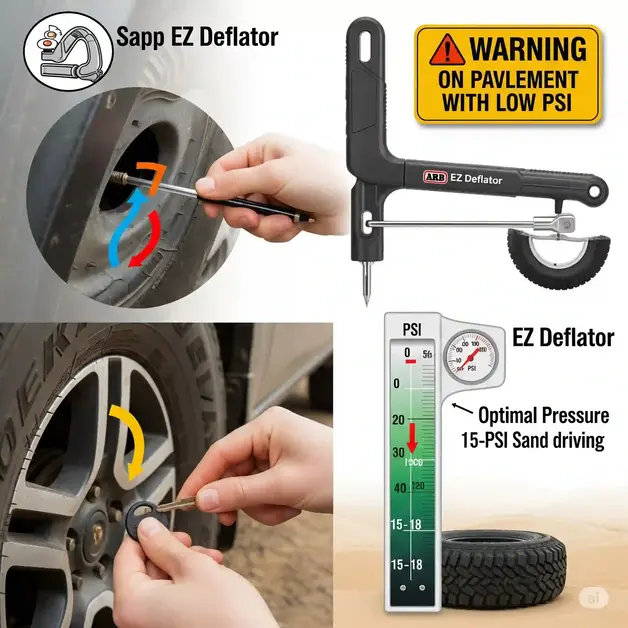
How do you let air out of a car tyre without tools?
To let air out without tools, press the valve stem pin using a key or pen. Air will escape. Check the PSI often so you don’t go too low.
How much air should I let out for sand driving?
Drop your tyre pressure to 15–18 PSI for sand driving. This helps your tyres spread out and “float” over soft sand for better grip and control.
Can I deflate tyres too much?
Yes, letting out too much air can cause tyres to sag or pop off the rim. For safety, avoid going below 15 PSI unless you have special off-road tyres.
Is it OK to drive with deflated tyres on pavement?
No, it’s unsafe. Low PSI on pavement causes heat build-up and poor control. Always reinflate tyres to 32–36 PSI before road driving.
How can I deflate tyres fast?
Use a tyre deflator tool like the ARB EZ Deflator. It removes the valve core and lets you control pressure drop quickly and safely.
Final Thoughts: Take Control of Your Tyre Pressure
If you like being ready for anything—whether it’s off-roading or just adjusting for heavy loads—learning how to deflate a tyre safely is a game-changer. But if you’re someone who’d rather leave all things tyre-related to a mechanic, this might not be for you. Personally, this skill saved me more than once on the trails and even during a long highway drive with a full trunk. It’s simple, smart, and gives you real control over your ride.

